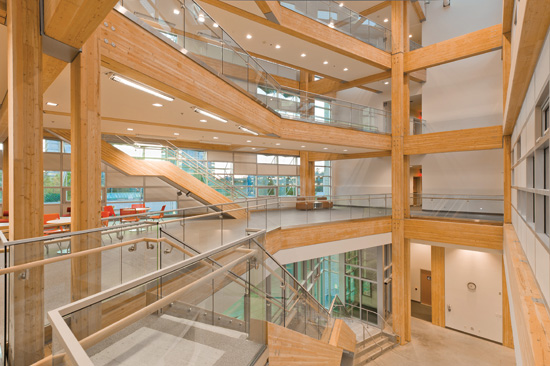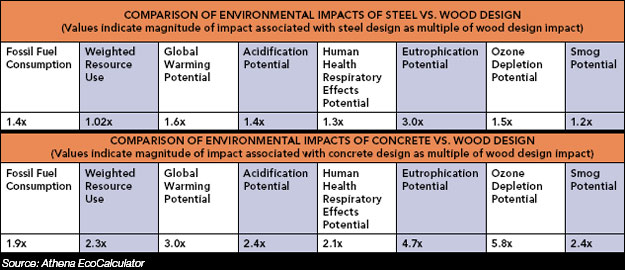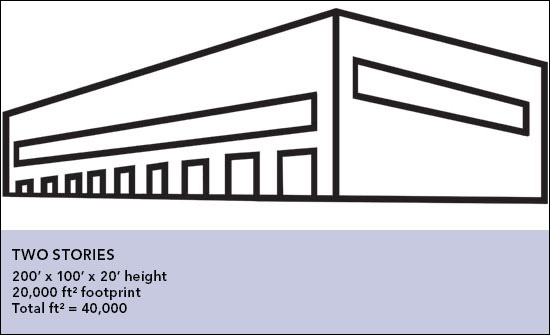Green Building and Wood Products
Life Cycle Assessment: Getting to a Material’s Real Green Quotient
Life cycle assessment is sometimes described as mysterious and complicated. Yet, what is involved is simply a thorough accounting of resource consumption, including energy, and emissions and wastes associated with production and use of a product. For a “product” as complex as a building, this means tracking and adding up inputs and outputs for all assemblies and subassemblies—every framing member, panel, fastener, finish material, coating, and so on. Further, to ensure that results and data developed by different LCA practitioners and in different countries are comparable (i.e., that results allow apple-to-apple comparisons), LCA practitioners must strictly adhere to a set of international guidelines set forth by the International Organization for Standardization.
Tracking products and co-products through a supply chain and properly allocating resource use, emissions, and wastes to various outputs can indeed be complicated and expensive. However, a growing number of LCA tools have made LCA a viable option for any designer. User-friendly, low-cost (in most cases free) tools, such as the Athena Impact Estimator for Buildings (IE), provide life cycle impact information for an extensive range of generic building assemblies, or designers can choose to undertake full building analyses. LCA-based data is also available in the form of standardized, easy-to-understand EPDs for a wide range of products.
The wood industry has been an early adopter of EPDs, undertaking research and developing life cycle information that verifies the environmental impact of wood building products. EPDs on wood products are available from the American Wood Council (www.awc.org) along with transparency briefs summarizing the most critical data presented in each. (For more information on EPDs, see the continuing education course Wood and Environmental Product Declarations.4)
Increased use of LCA in the evaluation of building design alternatives and material selection greatly favors wood in all types of construction, since environmental impacts across a large spectrum of indicators tend to be significantly lower for wood products than alternative materials.5 Scientific comparisons of functionally equivalent buildings, components, and subassemblies have been remarkably consistent in this regard, with wood almost invariably found to be the low-impact option.

Photo courtesy of University of British Columbia
Living Building Challenge; LEED Platinum (in process)
Center for Interactive Research on Sustainability, University of British Columbia – Vancouver, Canada
Architect: Perkins+Will
Seeking two of North America’s highest ratings, the building’s moment-frame structure allows for clear-span interior spaces, while its structural deck includes 2x4s sourced from forests affected by the mountain pine beetle infestation.
As an example of the environmental performance of wood structures in comparison to those constructed of other materials, a highly regarded and commonly used LCA tool, the Athena EcoCalculator, was used to evaluate three alternative configurations of a simple building. Designed for the Atlanta geographical area, the building footprint was 20,000 ft2 (100 ft x 200 ft). Two stories in height, the structure was 20 feet tall with 40,000 ft2 of total floor area. To simplify analysis and comparison of materials in particular, the theoretical building was analyzed without windows, doors, or internal partitions. Of the three configurations, one was wood, one steel, and one concrete. All were assumed built on a concrete foundation and slab.
This analysis involved systematic assessment using life cycle methodology of all building assemblies beginning with raw material extraction through primary and secondary manufacturing, transport at all stages of the production chain and to the job site, and building construction. Differences among the wood, steel, and concrete structures are shown in the table above.

Impacts associated with the steel design as compared to the wood design are mostly 1.3 to 1.6 times greater, with a range of 1.02 to 3.0 times. Lower impacts are indicated for the wood design in every impact category. Comparison of the concrete vs. wood design shows even greater differences. In this case, environmental impacts associated with the concrete design range from 1.9 to 5.8 times greater than for the wood design. Again, impacts across all indicators are lower for the wood design. The impact categories in the tables closely match those specified in rating tools and code language where use of LCA is encouraged or rewarded.
One reality consistently revealed by LCA is the low embodied energy in wood structures compared to those built of steel or concrete.6 The term 'embodied energy' refers to the total consumption of energy linked to production of a building, including resource extraction, manufacturing, transport, and installation of building materials. According to Dr. Bowyer, “The embodied energy of wood assemblies has consistently been found to be 20 to 70 percent lower than functionally equivalent steel or concrete assemblies.”

Comparison of the environmental impact measures linked to material selection obtained through LCA (tables on page 6) and material selection factors typically considered in prescriptive-based rating systems (page 2) reveals a startling reality. None of the prescriptive-based rating systems reward superior performance, or even consider in building material selection, such things as fossil fuel consumption, global warming potential, total resource use, non-renewable resource consumption, acidification or eutrophication potential, ozone depletion, smog potential, or water use. The reason is that any rating system that does not incorporate LCA or LCA-based tools and information does not have the capacity to consider these things. The same is true of prescriptive pathways within systems that do incorporate LCA and LCA-based tools and information, but do not require their use.









